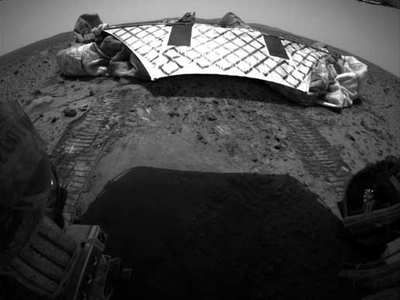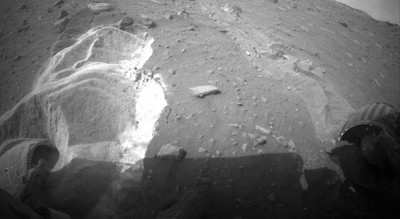Spirit Has Been Incommunicado Since March 22
 NASA mission controllers say they have not heard from the Mars
Exploration Rover Spirit since March 22, and the rover is facing
its toughest challenge yet - trying to survive the harsh Martian
winter.
NASA mission controllers say they have not heard from the Mars
Exploration Rover Spirit since March 22, and the rover is facing
its toughest challenge yet - trying to survive the harsh Martian
winter.
The rover team anticipated Spirit would go into a low-power
"hibernation" mode since the rover was not able to get to a
favorable slope for its fourth Martian winter, which runs from May
through November. The low angle of sunlight during these months
limits the power generated from the rover's solar panels. During
hibernation, the rover suspends communications and other activities
so available energy can be used to recharge and heat batteries, and
to keep the mission clock running.
On July 26, mission managers began using a paging technique
called "sweep and beep" in an effort to communicate with Spirit.
"Instead of just listening, we send commands to the rover to
respond back to us with a communications beep," said John Callas,
project manager for Spirit and Opportunity at NASA's Jet Propulsion
Laboratory in Pasadena, Calif. "If the rover is awake and hears us,
she will send us that beep."
Based on models of Mars' weather and its effect on available
power, mission managers believe that if Spirit responds, it most
likely will be in the next few months. However, there is a very
distinct possibility Spirit may never respond. "It will be the
miracle from Mars if our beloved rover phones home," said Doug
McCuistion, director of NASA's Mars Exploration Program in
Washington. "It's never faced this type of severe condition before
- this is unknown territory."

NASA Spirit Rover In 2004
Because most of the rover's heaters were not being powered this
winter, Spirit is likely experiencing its coldest internal
temperatures yet -- minus 67 degrees Fahrenheit. During three
previous Martian winters, Spirit communicated about once or twice a
week with Earth and used its heaters to stay warm while parked on a
sun-facing slope for the winter. As a result, the heaters were able
to keep internal temperatures above minus 40 degrees
Fahrenheit.
Spirit is designed to wake up from its hibernation and
communicate with Earth when its battery charge is adequate. But if
the batteries have lost too much power, Spirit's clock may stop and
lose track of time. The rover could still reawaken, but it would
not know the time of day, a situation called a "mission-clock
fault." Spirit would start a new timer to wake up every four hours
and listen for a signal from Earth for 20 minutes of every hour
while the sun is up.
The earliest date the rover could generate enough power to send
a beep to Earth was calculated to be around July 23. However,
mission managers don't anticipate the batteries will charge
adequately until late September to mid-October. It may be even
later if the rover is in a mission-clock fault mode. If Spirit does
wake up, mission managers will do a complete health check on the
rover's instruments and electronics.
Based on previous Martian winters, the rover team anticipates
the increasing haziness in the sky over Spirit will offset longer
daylight for the next two months. The amount of solar energy
available to Spirit then will increase until the southern Mars
summer solstice in March 2011. If we haven't heard from it by
March, it is unlikely that we will ever hear from it.
"This has been a long winter for Spirit, and a long wait for
us," said Steve Squyres, the principal investigator for NASA's two
rovers, who is based at Cornell University. "Even if we never heard
from Spirit again, I think her scientific legacy would be secure.
But we're hopeful we will hear from her, and we're eager to get
back to doing science with two rovers again."

NASA Spirit Rover In 2009
Spirit and its twin, Opportunity, began exploring Mars in
January 2004 on missions planned to last three months. Spirit has
been nearly stationary since April 2009, while Opportunity is
driving toward a large crater named Endeavour. Opportunity covered
more distance in 2009 than in any prior year. Both rovers have made
important discoveries about wet environments on ancient Mars that
may have been favorable for supporting microbial life.
NASA's JPL manages the Mars Exploration Rover project for NASA's
Science Mission Directorate in Washington.
 ANN's Daily Aero-Term (04.24.24): Runway Lead-in Light System
ANN's Daily Aero-Term (04.24.24): Runway Lead-in Light System ANN's Daily Aero-Linx (04.24.24)
ANN's Daily Aero-Linx (04.24.24) Aero-FAQ: Dave Juwel's Aviation Marketing Stories -- ITBOA BNITBOB
Aero-FAQ: Dave Juwel's Aviation Marketing Stories -- ITBOA BNITBOB Classic Aero-TV: Best Seat in The House -- 'Inside' The AeroShell Aerobatic Team
Classic Aero-TV: Best Seat in The House -- 'Inside' The AeroShell Aerobatic Team Airborne Affordable Flyers 04.18.24: CarbonCub UL, Fisher, Affordable Flyer Expo
Airborne Affordable Flyers 04.18.24: CarbonCub UL, Fisher, Affordable Flyer Expo





